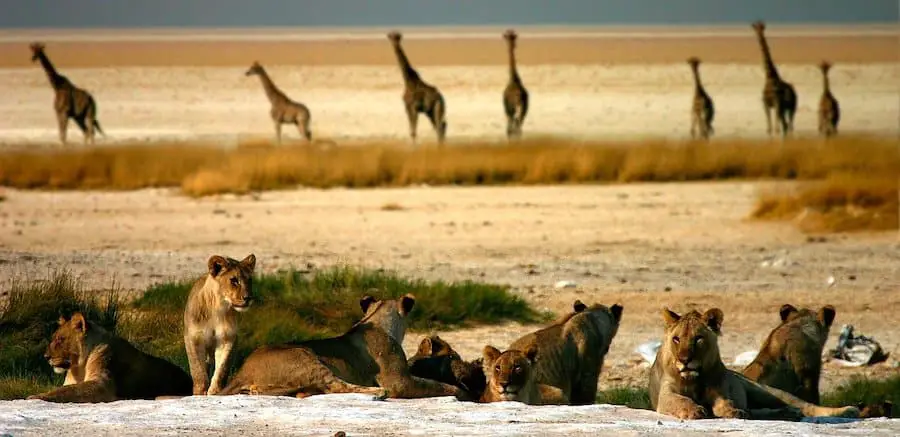The lion is indeed not just the king of the jungle but arguably the king of predators. But do Lions eat Giraffes?
But have you ever wondered if these short but strong animals can eat the tallest of animals like Giraffes? This article will provide a clear understanding of whether lions eat giraffes and much more.
Lions do eat giraffes, but not very often. It’s a risky and tough hunt for Lions. When they do, they target the young, helpless, sick, pregnant, and weak giraffes over healthy ones. Lions usually attack giraffe from behind, stumble them to the ground, choke the throat to death, and then eat them.
But how would a giraffe defend itself? And how many Lions would it require? Let’s dive into this topic further and give you more information on how this all happens…
Lions are one of the main predators of giraffe
Because of its remarkable height in the animal kingdom, it’s not surprising most people would think other animals would not be able to bring down a giraffe.
But surprisingly enough some animals do eat giraffes and lions are one of the main predators of giraffes.
Hunting down a giraffe is a risky business for lions. From the complicated approach in reaching the heights of a giraffe’s body and neck to the high risk of being injured through the strong defensive mechanisms that Giraffes have – more on how a giraffe defends itself later.
Lions don’t prey on adult giraffes often. Lions eat adult giraffes only when food is rare and they need to get into the risky hunting to fill themselves.
Usually, this means Lions target the young, weak, sick, unhealthy, pregnant, or disabled giraffes that make it easier for them to bring them down.
Of these types, young giraffes are the main prey that lions hunt for.
And according to estimations around 75% of young giraffes don’t survive till adulthood because of becoming the victim of predators like lions.
This again comes because baby giraffes need to be mostly lying on the ground for the first couple of weeks after birth.
When giraffes are lying on the ground, it’s a much easier target for lions to prey on. Even though mother giraffes do their best to keep these baby giraffes close and safe.
Often it’s through misadventure that baby giraffe becomes prey to lions. Out of their new curiosity and lack of awareness about predators, baby giraffes will try to explore, making them an easy target for lions.
But giraffe aren’t the onyl thing lions hunt. Here’s a list of the main animals a lion preys on.

Lions hunt giraffe in packs called a pride
A single lion has almost zero chance of bringing down a giraffe on its own, unless the giraffe is already disabled or struggling in some way, or if it’s a young left alone.
But lions rarely hunt alone. They hunt in a pack called a “pride”. A pride of lions works excellent as a team in assaulting their prey from a number of points.
How lions attack giraffes
Even for a pride of lions, taking down a tall tower of a beast is not an easy job to accomplish, but they do have some excellent and well-honed tactics to give their giraffe hunting a greater chance of success.
Lions rely on their strong and powerful forelimbs and their retractable claws for initially grappling with their prey. They use these to grab hold and maintain a purchase on the prey.
Other predators like Hyenas prey on giraffes using their strong teeth and jaws. So when a hyena hunts a giraffe they leave puncture wounds on the body, along with the traces of their teeth carved on the skin of giraffes.
But because lions use their claws for attacking, they leave traces of sharp and parallel incisions on the giraffe’s skin. These traces are more akin to deep scratch marks similar to that of fingernails dragged through the mud.
These claw marks are usually found on the hindquarters of giraffes. This demonstrates that lions generally attack giraffes from behind.
Why lions attack giraffe from behind
The reason why lions use this attacking method is very practical.
Firstly when they attack from behind, it’s harder for the giraffe to see them, to attack back, or to get away from a lion on its back.
Secondly, it’s easier to stumble the giraffe to the floor by attacking its legs from behind.
Finally and the most important reason is, the skin and the front part of the body including the neck are generally thicker.
Thicker skin is more difficult for the lion to penetrate. Whereas the hindquarters of the giraffe have thinner skin, which is easier to obtain a grip of.
The main objective in a lion’s attacking mechanism is to bring the giraffe to the ground, doing so makes the hunt a lot easier.
Lions first try to get the legs of the giraffe tangled so they trip and fall to the ground. This is also why lions attack from behind.
Once the giraffe is on the ground, the lions will seek to clamp their jaws around the giraffe’s throat. and choke the giraffe by the throat. This is not specific to giraffe, this approach happens in most cases when lions attack their prey.
After some moments of struggling, this will succeed in killing the giraffe. After which the lions will, of course, have their intended meal.
This method of attacking from behind, stumbling, and then choking may not always lead to success – and in fact, in most cases, it doesn’t work. It’s also complicated and dangerous.
So as a first option, lions always try to attack giraffes when the giraffe is drinking water or when bending down, so their neck is at ground level which is easier to reach and choke. This is rare though, as giraffes will most likely sense lions in their near vicinity.

When a giraffe is most at risk of lion attack
Giraffes living in dense woodlands are at greater risk of being hunted or attacked than giraffes living in grassland. Find out more about where giraffes live.
This is because giraffes can more easily see lions when in open areas like grassland and plains, than dense woodland. In dense undergrowth, lions can hide better, get closer, and surprise a giraffe far more easily.
A giraffe meal is not an easy win for lions
In general, healthy adult giraffes are less vulnerable to being eaten by lions because they boast some amazing defensive characteristics.
Here are some of the ways giraffe defend themselves from lions and other prey:
- A giraffe is an intimidating size, making it hard for many predators to atack successfully.
- Giraffes can deal a deadly kick using their legs. These kicks can severely injure a predator, or cause internal injuries leading to death.
- Giraffes run fast because they have long longs and take long strides. A faster running speed is hard to catch up to for lions.
- Giraffes have good vision, in part due to their height. They have a 360-degree view of their surroundings, which can warn them of any predators. As an interesting fact, they even warn other animals like zebras of possible predators closing in, allowing them more time to escape too.
Even if giraffes can escape attacks by lions, these attacks can be miserable.
Especially if giraffes are left with amputated tails as they use these to brush away insects biting them or to clean themselves from thorns pricking their skins. Worse still, any wound could become infected and lead to death later.
Conclusion
We hope this has provided a good response to the questions Do lions eat Giraffe. Be sure to check out other articles to learn lots more things you might not know about how nature works.
